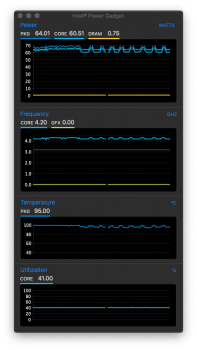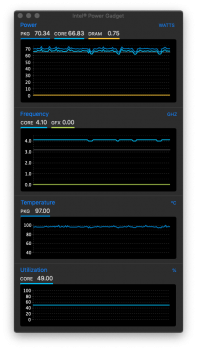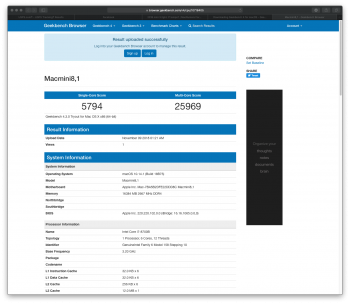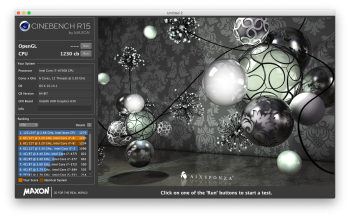There seems to be some recurring confusion in the forums regarding the three CPU options available for the 2018 Mini. The Mini can be configured with:
The answer is NO.
All of the CPUs, when idling or lightly loaded, will run well below these frequencies. When heavily loaded, however:
![upload_2018-11-19_9-47-2.png upload_2018-11-19_9-47-2.png]()
With 5 cores loaded, it runs at a stable 4.2GHz, occassionally flirting with 4.3GHz, again above the maximum of the i5 and i3:
![upload_2018-11-19_9-47-45.png upload_2018-11-19_9-47-45.png]()
With 6 cores loaded, it runs at 4.1GHz, occassionally flirting with 4.0GHz, also above the i3, and right around the i5's maximum:
![upload_2018-11-19_9-48-20.png upload_2018-11-19_9-48-20.png]()
Your next question might be "so, the i5 can be as fast the i7 sometimes, right?"
Again, almost always NO. Besides having more L3 cache and a higher maximum boost clock, the i7 is hyperthreaded. The i7 will be on average 10-20% faster than the i5 with equivalent workloads. There are of course exceptions in either direction, but this average tends to hold true empirically.
For reference, here is my Geekbench score:
![upload_2018-11-19_9-55-25.png upload_2018-11-19_9-55-25.png]()
And Cinebench R15. The 1204 score is after four sequential runs once the temperature had stabilized. The 1230 score is the one I obtained about 15 minutes before writing this post:
![upload_2018-11-19_9-56-18.png upload_2018-11-19_9-56-18.png]()
The final question I see a lot is "is it safe for CPUs to run at nearly 100°C for sustained periods of time?"
The answer is, empirically, YES. Except for extreme use cases, this is a perfectly acceptable (and within specifications) temperature for the CPU to run at. CPUs can easily live for 20 years. Is it ideal for the CPU's life to run 24/7/365 at maximum temperature for several years? No, simple thermodynamics will tell you that. Even so, how many of you reading this plan on keeping your i7 100% loaded 24/7/365 for five or 10 years straight? How many of you in that scenario don't utilize your own rigorous testing methods before such a deployment anyhow?
The bottom line is you either trust Intel and Apple's engineers or you don't. My intention here is not to change your mind if you don't. We've just not seen it empirically born out where high (but within specification) temperatures in Intel's modern CPU offerings leads to significant reductions in their useful lifespans.
I will update this first post if we get similar format data for the i5/i3 or any other noteworthy developments occur.
References
- i3-8100B:
- 4 cores (4 threads)
- 6MiB L3 cache
- 2.4GHz DRAM
- Max clock speed 3.6GHz
- Max iGPU clock speed 1.1GHz
- i5-8500B:
- 6 cores (6 threads)
- 9MiB L3 cache
- 2.666GHz DRAM
- Base clock speed 3.0GHz, max turbo boost clock speed 4.1GHz
- Max iGPU clock speed 1.1GHz
- i7-8700B:
- 6 cores (12 threads)
- 12MiB L3 cache
- 2.666GHz DRAM
- Base clock speed 3.2GHz, max turbo boost clock speed 4.6GHz
- Max iGPU clock speed 1.2GHz
The answer is NO.
All of the CPUs, when idling or lightly loaded, will run well below these frequencies. When heavily loaded, however:
- The i3 will ramp up to at most 3.6GHz.
- The i5 will ramp up to at most 4.1GHz depending on how many cores are loaded, but never less than the i3 with equivalent load.
- The i7 will ramp up to at most 4.6GHz depending on how many cores are loaded, but never less than the i5 with equivalent load.

With 5 cores loaded, it runs at a stable 4.2GHz, occassionally flirting with 4.3GHz, again above the maximum of the i5 and i3:

With 6 cores loaded, it runs at 4.1GHz, occassionally flirting with 4.0GHz, also above the i3, and right around the i5's maximum:

Your next question might be "so, the i5 can be as fast the i7 sometimes, right?"
Again, almost always NO. Besides having more L3 cache and a higher maximum boost clock, the i7 is hyperthreaded. The i7 will be on average 10-20% faster than the i5 with equivalent workloads. There are of course exceptions in either direction, but this average tends to hold true empirically.
For reference, here is my Geekbench score:

And Cinebench R15. The 1204 score is after four sequential runs once the temperature had stabilized. The 1230 score is the one I obtained about 15 minutes before writing this post:

The final question I see a lot is "is it safe for CPUs to run at nearly 100°C for sustained periods of time?"
The answer is, empirically, YES. Except for extreme use cases, this is a perfectly acceptable (and within specifications) temperature for the CPU to run at. CPUs can easily live for 20 years. Is it ideal for the CPU's life to run 24/7/365 at maximum temperature for several years? No, simple thermodynamics will tell you that. Even so, how many of you reading this plan on keeping your i7 100% loaded 24/7/365 for five or 10 years straight? How many of you in that scenario don't utilize your own rigorous testing methods before such a deployment anyhow?
The bottom line is you either trust Intel and Apple's engineers or you don't. My intention here is not to change your mind if you don't. We've just not seen it empirically born out where high (but within specification) temperatures in Intel's modern CPU offerings leads to significant reductions in their useful lifespans.
I will update this first post if we get similar format data for the i5/i3 or any other noteworthy developments occur.
References
- Intel's data sheets for the i3, i5 and i7:
https://ark.intel.com/products/126688/Intel-Core-i3-8100-Processor-6M-Cache-3-60-GHz-
https://ark.intel.com/products/134892/Intel-Core-i5-8500B-Processor-9M-Cache-up-to-4-10-GHz-
https://ark.intel.com/products/134905/Intel-Core-i7-8700B-Processor-12M-Cache-up-to-4-60-GHz- - Coffee Lake architecture overview:
https://en.wikichip.org/wiki/intel/microarchitectures/coffee_lake - Intel's original hypertheading journal article:
http://www.cs.virginia.edu/~mc2zk/cs451/vol6iss1_art01.pdf - Wikipedia article on hyperthreading:
https://en.wikipedia.org/wiki/Hyper-threading - Intel's Turbo Boost 2.0 primer:
https://www.intel.com/content/www/u...ology/turbo-boost/turbo-boost-technology.html - Sandy Bridge Power Management Overview:
http://www.hotchips.org/wp-content/...3.19.921.SandyBridge_Power_10-Rotem-Intel.pdf
- Single-channel vs. dual-channel RAM w/ i5:
https://forums.macrumors.com/threads/2018-mini-8gb-vs-20gb-benchmark.2156474/ - Logic i7 benchmarks:
https://forums.macrumors.com/threads/anyone-running-logic-on-the-i7-and-could-do-me-a-favor.2157688/
Last edited:

